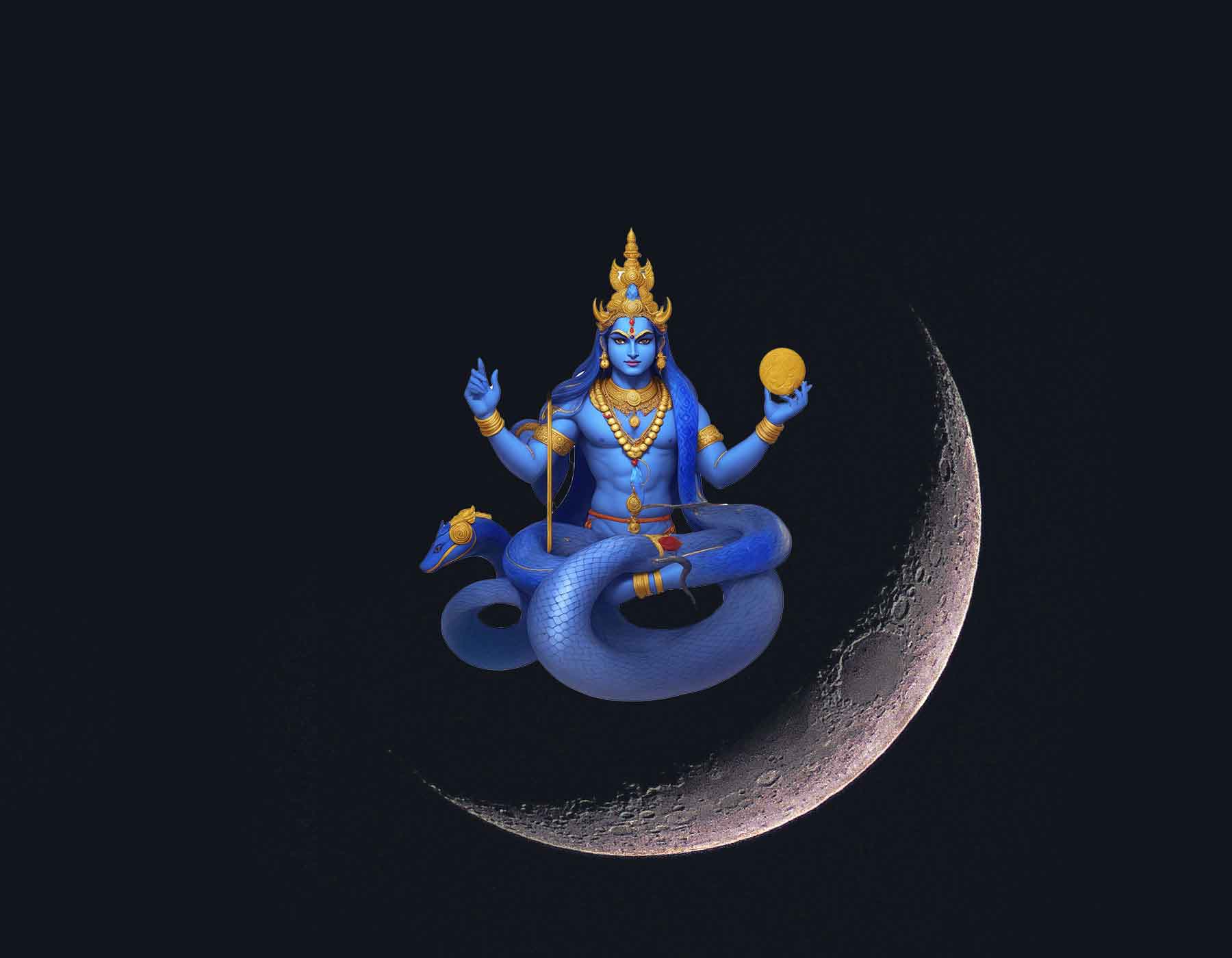Rahu and Ketu

Rahu and Ketu - just the sound of these names can make us feel uneasy. We have been led to believe that these planets are malefic and only bring negative energy into our lives.
the myth surrounding Rahu and Ketu has created a lot of confusion and chaos. People often talk about these planets in negative and scary ways, which can be overwhelming and irrational. But is that really true? Are these shadow planets really here to harm us? Let's try to examine this in a simple and scientific manner.
The Astronomy and Cosmology of Rahu and Ketu - The Scientific Facts
Rahu and Ketu are not physical bodies in our solar system but are two mathematical points or nodes in the sky where the paths of the Sun, Moon, and Earth intersect. In this context, Rahu is the north node and Ketu is the south node. Their importance in astrology stems from the fact that they represent the points where the Moon's orbit intersects with the plane of the Earth's orbit around the Sun.
As the Moon orbits the Earth, it crosses the ecliptic (the apparent path of the Sun in the sky) twice during each lunar orbit. When the Moon crosses the ecliptic from south to north, it is known as Rahu, and when it crosses the ecliptic from north to south, it is known as Ketu. These crossings are known as lunar nodes and are significant in both astronomy and astrology. In Vedic astrology, the lunar nodes are called Rahu and Ketu and are considered to be shadow planets.
In astronomy, the nodes of the Moon are important because they affect the orientation of the Moon's orbit relative to the Earth-Sun plane. The gravitational influence of the Sun and Earth on the Moon's orbit causes the nodes to move slowly over time. This phenomenon is known as precession and is responsible for changing the orientation of the Moon's orbit over long periods of time
The effect of Rahu and Ketu ( Lunar Nodes ) on Human Body
The moon's gravitational pull is a well-known natural force that affects the Earth and its inhabitants in various ways. While the scientific community remains divided on whether the moon's phases have a direct impact on human behavior, the concept of the lunar effect remains an area of interest for many researchers.
One area of interest is the potential impact of the moon's gravitational pull on the human body. As mentioned earlier, the human body is largely composed of water, which is known to be affected by the moon's gravitational pull. Some researchers have suggested that this gravitational force may influence the body's biological rhythms, including the circadian rhythm that regulates sleep and wake cycles. Others have proposed that the moon's influence on the body may extend to other physiological processes, such as blood pressure, heart rate, and hormone levels. For example, some studies have shown that there may be a correlation between lunar phases and an increased risk of cardiovascular events, such as heart attacks and strokes. However, more research is needed to establish a clear cause-and-effect relationship.
The moon's cycles have been linked to women's menstrual cycles, which may have contributed to the belief that the moon affects human behavior. The idea that the moon's cycles are linked to women's menstrual cycles has been around for a long time, and it is a belief that is still held by some people today. The concept is based on the observation that the length of a lunar cycle (29.5 days) is similar to the average length of a menstrual cycle (28 days). One theory behind this belief is that the moon's gravitational pull affects the water in the human body, just as it affects the tides. Since the human body is largely composed of water, it is thought that the moon's gravitational pull might also influence the menstrual cycle.
In addition to the moon's gravitational pull, the lunar nodes Rahu and Ketu also play a significant role in Vedic astrology and Hindu mythology. According to Vedic astrology, Rahu and Ketu are associated with different parts of the body and can affect them in different ways. Rahu is said to govern the head and can cause mental health issues such as anxiety and depression. Ketu, on the other hand, is associated with the lower body and can cause physical ailments such as joint pain and digestive issues.
The effect of Rahu and Ketu ( Lunar Nodes ) on Human Mind and Emotions
Another area of interest is the potential impact of the moon's phases on human emotions and mental health. Many cultures throughout history have associated the moon with various psychological and spiritual phenomena, leading to the development of lunar myths and legends. The idea that the moon affects human behavior and emotions is often referred to as the "lunar effect" . One possible explanation for this belief is that the moon's cyclical phases and its position in the sky have been used as a way to measure time and mark important cultural and religious events. This has led to the moon being associated with various archetypes and symbols that can evoke deep emotional responses.
Some researchers have suggested that the moon's phases may have a direct impact on human mood and behavior. For example, the full moon has long been associated with increased aggression and violent behavior in humans, as well as higher rates of hospital admissions and emergency room visits. However, the scientific evidence supporting these claims is mixed, and more research is needed to establish a clear link between the lunar cycle and human behavior.
The Astrological significance of Rahu and Ketu ( Lunar Nodes )
The lunar nodes, also known as Rahu ( North Node ) and Ketu (South Node), are two points in space that are directly opposite each other and are used in astrology to interpret a person's natal chart . In Vedic astrology, Rahu and Ketu are considered to be important points that influence a person's life at the time of their birth and throughout their lifetime. These celestial points are believed to have a strong influence on human emotions and the subconscious mind. That’s is why Rahu is associated with our desires and obsessions, while Ketu is associated with spiritual growth and liberation.
When Rahu and Ketu are placed in certain houses of a person's birth chart or during their transit, they are believed to affect the energy flow in those areas of life, which in turn can impact a person's emotional state. For example, if Rahu is placed in the house of career, a person may become overly ambitious or obsessed with their work, while Ketu in the same house can make them detached from their professional goals. While the influence of celestial bodies like Rahu and Ketu on human life is widely accepted in Vedic astrology ,further research is needed to establish a clear link between the lunar effect and human health and behavior, but it's clear that the moon and other celestial bodies continue to captivate our imaginations and inspire wonder and awe.
However, it's important to note that Rahu and Ketu's effects are not entirely negative, as they can also bring about positive changes and growth in one's life.
The Significance of Rahu and Ketu and their Role in in understanding an individual's karmic journey and soul's evolution – The Spiritual side
Rahu and Ketu , also known as the Lunar Nodes, are believed to play a significant role in the spiritual journey of an individual. They are said to influence not only the present life but also the past and future lives. In this regard, understanding the nature and influence of the Lunar Nodes can provide valuable insights into an individual's karmic patterns and life purpose. In Vedic astrology, the North and South Nodes of the Moon, also known as Rahu and Ketu, respectively, play a significant role in understanding an individual's karmic journey and soul's evolution.
The North Node, or Rahu, is considered a point of growth and evolution. It represents the direction in which an individual's soul is moving towards in this lifetime. It is associated with the future, and the lessons and experiences that need to be learned in order to move forward on the soul's journey. The placement of the North Node in a person's birth chart can indicate the areas of life where they are likely to experience growth, challenges, and new opportunities. These experiences may not always be easy or comfortable, but they are essential for spiritual growth and evolution.
On the other hand, the South Node, or Ketu, is considered a point of release and detachment. It represents the karmic patterns and habits that need to be released in order to move forward on the soul's journey. It is associated with the past, and the lessons and experiences that have already been learned in past lives. The placement of the South Node in a person's birth chart can indicate the areas of life where they may feel a strong sense of familiarity, comfort, and even attachment. However, these areas may also represent karmic patterns that need to be released in order to move forward on the soul's journey.
Finally we can say that the North Node represents the direction in which an individual's soul is evolving in this lifetime, while the South Node represents the karmic patterns and habits that need to be released in order to move forward. Both nodes are essential in understanding an individual's karmic journey and spiritual growth, and their placement in a person's birth chart can provide valuable insights into their life purpose, strengths, challenges, and opportunities for growth and evolution.
Click here to watch the video (English):
Click here to watch the video (Hindi):





















